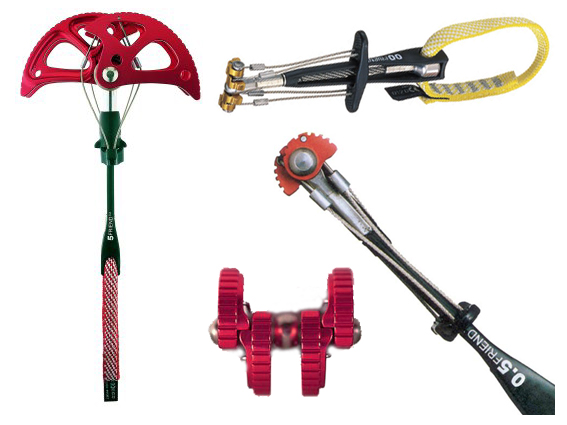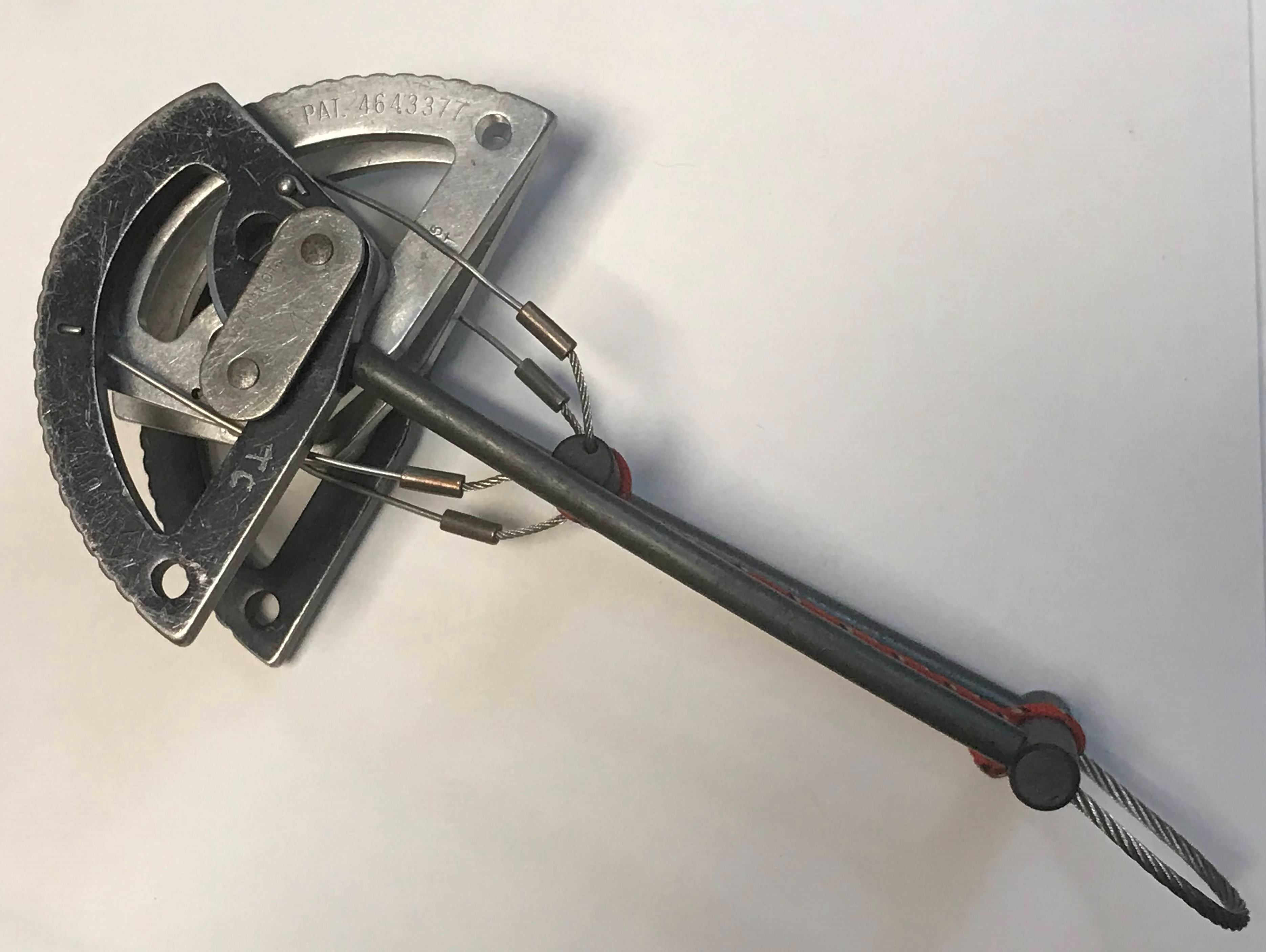|
SLCD
A spring-loaded camming device (also SLCD, cam or friend) is a piece of rock climbing or mountaineering Protection (climbing), protection Climbing equipment, equipment. It consists of two, three, or four Cam (mechanism), cams mounted on a common axle or two adjacent axles, so that pulling on the axle forces the cams to spread further apart. It is then attached to a sling (climbing equipment), sling and carabiner at the end of the stem. The SLCD is used by pulling on the "trigger" (a small handle) so that the cams retract together, then inserting it into a crack or pocket in the rock and releasing the trigger to allow the cams to expand. A pull on the rope, such as that generated by a climber falling, will cause a properly placed SLCD to convert the pulling force along the stem of the unit into outwards pressure on the rock, producing massive amounts of friction and preventing the removal of the unit from the rock. Due to the large forces exerted on the rock when an SLCD is fallen ... [...More Info...] [...Related Items...] OR: [Wikipedia] [Google] [Baidu] |
Protection (climbing)
Rock-climbing equipment varies with the specific type of climbing that is undertaken. Bouldering needs the least equipment outside of climbing shoes, climbing chalk and optional crash pads. Sport climbing adds ropes, harnesses, belay devices, and quickdraws to clip into pre-drilled bolts. Traditional climbing adds the need to carry a "rack" of temporary passive and active protection devices. Multi-pitch climbing, and the related big wall climbing, adds devices to assist in ascending and descending fixed ropes. Finally, aid climbing uses unique equipment to give mechanical assistance to the climber in their upward movement (e.g. aiders). Advances in equipment are a key part of the rock climbing history, starting with the climbing rope. Modern devices enable climbers to perform tasks previously done manually, with greater control – in all conditions – and with less effort. Examples of replacements include the harness (replaced tying the rope around the waist) ... [...More Info...] [...Related Items...] OR: [Wikipedia] [Google] [Baidu] |
Rock Climbing
Rock climbing is a climbing sports discipline that involves ascending climbing routes, routes consisting of natural rock in an outdoor environment, or on artificial resin climbing walls in a mostly indoor environment. Routes are documented in climbing guidebook, guidebooks, and on online databases, detailing how to climb the route (called the beta (climbing), beta), and who made the first ascent (or FA) and the coveted First ascent#In rock climbing, first free ascent (or FFA). Climbers will try to ascend a route onsight, however, a climber can spend years projecting (climbing), projecting a route before they make a redpoint (climbing), redpoint ascent. Routes range from a few metres to over a in height, and traverse (climbing), traverses can reach in length. They include slab climbing, slabs, face climbing, faces, crack climbing, cracks and overhang (climbing), overhangs/roofs. Popular rock types are granite (e.g. El Capitan), limestone (e.g. Verdon Gorge), and sandstone (e ... [...More Info...] [...Related Items...] OR: [Wikipedia] [Google] [Baidu] |
Traditional Climbing
Traditional climbing (or trad climbing) is a type of free climbing in rock climbing where the lead climber places removable protection while simultaneously ascending the route; when the lead climber has completed the route, the second climber (or belayer) then removes this protection as they ascend the route. Traditional climbing differs from sport climbing where the protection equipment is already pre-drilled into the rock in the form of bolts. Traditional climbing is still the dominant format on longer multi-pitch routes, including alpine and big wall. Traditional climbing carries a much higher level of risk than bolted sport climbing as the climber may not have placed the protection equipment correctly while ascending the route, or there may be few opportunities to insert satisfactory protection (e.g. on very difficult routes). Traditional climbing was once the dominant form of free climbing but since the mid-1980s, sport climbing — and its related form of competition ... [...More Info...] [...Related Items...] OR: [Wikipedia] [Google] [Baidu] |
Tricam
A tricam is a type of climbing protection equipment. A versatile nut/cam hybrid, the Tricam was invented by Greg Lowe in 1973, and came to market in 1981. They are currently manufactured by C.A.M.P. of Premana Italy. Design The Tricam is a passive camming device consisting of a carefully shaped aluminium-alloy cam attached to a length of webbing tape. Most sizes are produced as a solid forged unit, but the larger sizes are made from riveted sheet metal. The device is inserted into a crack so that pulling on the tape makes the piece cam outward against the sides of the crack, gripping the rock tighter. Camming action is achieved by the position of the pointed fulcrum or pivot of the cam relative to the attachment of the tape. As the webbing is pulled, the downward force is pivoted onto the point, which can bite into soft rock or ice and increases the holding power of the tricam. [...More Info...] [...Related Items...] OR: [Wikipedia] [Google] [Baidu] |
Camalot
Camalot is a brand of spring-loaded camming devices manufactured by Black Diamond Equipment used to secure ropes while rock climbing. Camalots use a dual-axle system, resulting in a slightly higher expansion range than similarly sized single axle units, however that results in significant weight penalty. Dual-axle was patented and for decades was only used by Black Diamond, however the patent has expired in 2005 and several other manufacturers began producing dual-axel cams, often also replicating Camalots sizes and coloring. Most notable Camalot look-alikes include DMM Dragons and Wild Country's New Friends. Like other cams, Camalot lobes are in the shape of a logarithmic spiral A logarithmic spiral, equiangular spiral, or growth spiral is a self-similarity, self-similar spiral curve that often appears in nature. The first to describe a logarithmic spiral was Albrecht Dürer (1525) who called it an "eternal line" ("ewi ..., resulting in a constant angle between the cam and ... [...More Info...] [...Related Items...] OR: [Wikipedia] [Google] [Baidu] |
Ray Jardine
Ray Jardine (born in 1944) is an American rock climbing, rock climber and rock-climbing equipment innovator, who specialized in traditional climbing and big wall climbing. In 1977, Jardine made the first free ascent of ''The Phoenix'', which was the List of grade milestones in rock climbing#Redpointed by men, first-ever consensus route at the grade of in climbing history. In 1979, with Bill Price, he became the first to free climbing, free climb the ''West Face'' of El Capitan in Yosemite Valley. Jardine is noted for inventing and developing the spring-loaded camming devices (SLCDs, also called "Friends") with the late Mark Vallance, which revolutionized traditional climbing in the late 1970s. He is also noted for his major contributions to the ultralight backpacking community through his books and his "make-it-yourself" gear company, Ray-Way Products. Early life Born in Colorado Springs, Colorado, as a youth, Jardine climbed Colorado's Pikes Peak dozens of times, mostly solo, ... [...More Info...] [...Related Items...] OR: [Wikipedia] [Google] [Baidu] |
Camalot Number 6
Camalot is a brand of spring-loaded camming devices manufactured by Black Diamond Equipment used to secure ropes while rock climbing. Camalots use a dual-axle system, resulting in a slightly higher expansion range than similarly sized single axle units, however that results in significant weight penalty. Dual-axle was patented and for decades was only used by Black Diamond, however the patent has expired in 2005 and several other manufacturers began producing dual-axel cams, often also replicating Camalots sizes and coloring. Most notable Camalot look-alikes include DMM Dragons and Wild Country (company), Wild Country's New Friends. Like other spring-loaded camming device, cams, Camalot lobes are in the shape of a logarithmic spiral, resulting in a constant angle between the cam and the rock at each contact point; this constant angle is designed to always provide the necessary friction to hold a cam in equilibrium. Models Black Diamond has produced several different models of Cam ... [...More Info...] [...Related Items...] OR: [Wikipedia] [Google] [Baidu] |
Mark Vallance
Mark Vallance (1946 – 19 April 2018) was a British rock climber, mountaineer and founder of Wild Country, a climbing equipment company. Founder of Wild Country He was instrumental in the design and development of a range of new equipment. American climber Ray Jardine, a climbing partner, had developed the first SLCD which were called "friends" by Yosemite climbers who had seen Jardine's climbs. Vallance took out a second mortgage on his house around 1977 so that he and Ray could produce "friends". A particularly successful design was a spring-loaded camming device branded the 'Friend'. It was revolutionary as a form of climbing protection, enabling climbers to tackle routes involving parallel or flared cracks in relative safety. Mountaineering career Vallance was a member of numerous Himalayan climbing expeditions, including one to Broad Peak. Wider climbing roles Vallance was co-founder and part of the build team of the Foundry Climbing Wall in Sheffield—the firs ... [...More Info...] [...Related Items...] OR: [Wikipedia] [Google] [Baidu] |
Piton
A piton (; also called ''pin'' or ''peg'') in big wall climbing and in aid climbing is a metal spike (usually steel) that is driven into a crack or seam in the climbing surface using a Rock climbing hammer, climbing hammer, and which acts as an anchor for protection (climbing), protecting the climber from falling or to assist progress in aid climbing. Pitons are equipped with an eye hole or a ring to which a carabiner is attached; the carabiner can then be directly or indirectly connected to a climbing rope. Pitons were the original form of protection (climbing), protection and are still used where there is no alternative. Repeated hammering and extraction of pitons damage the rock, and climbers who subscribe to the clean climbing ethic avoid their use as much as possible. With the popularization of clean climbing in the 1970s, pitons were largely replaced by faster and easier-to-use clean protection, such as nut (climbing), nuts and spring-loaded camming device, camming devi ... [...More Info...] [...Related Items...] OR: [Wikipedia] [Google] [Baidu] |
Klim Friends .
*
{{Disambiguation, callsign ...
Klim may refer to: * Klim (surname), a list of people and fictional characters * Klim (given name), a list of people and fictional characters * Klim (TV series), a Russian TV show * Klim (powdered milk), a powdered milk product * Klim (clothing), a clothing company * Klim, Denmark, a village * Klim Type Foundry * KCRN (AM), a radio station licensed to Limon, Colorado, United States, which held the call sign KLIM from 1984 to 2018 See also * ''Niels Klim's Underground Travels'', a satirical science-fiction/fantasy novel written by the Norwegian–Danish author Ludvig Holberg Ludvig Holberg, Baron of Holberg (3 December 1684 – 28 January 1754) was a writer, essayist, philosopher, historian and playwright born in Bergen, Norway, during the time of the Denmark–Norway, Dano–Norwegian dual monarchy. He was infl ... [...More Info...] [...Related Items...] OR: [Wikipedia] [Google] [Baidu] |
Clean Climbing
Clean climbing is rock climbing techniques and equipment which climbers use in order to avoid damage to the rock. These techniques date at least in part from the 1920s and earlier in England, but the term itself may have emerged in about 1970 during the widespread and rapid adoption in the United States and Canada of nuts (also called chocks), and the very similar but often larger hexes, in preference to pitons, which damage rock and are more difficult and time-consuming to install. Pitons were thus eliminated in North America as a primary means of climbing protection in a period of less than three years. Due to major improvements in equipment and technique, the term ''clean climbing'' has come to occupy a far less central, and somewhat different, position in discussions of climbing technology, compared with that of the brief and formative period when it emerged four decades ago. Rock preservation Drilled and hammered equipment such as bolts, pitons, copperheads and others sca ... [...More Info...] [...Related Items...] OR: [Wikipedia] [Google] [Baidu] |






